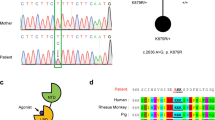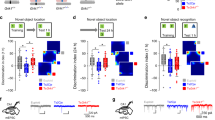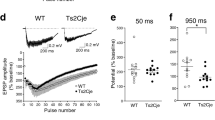Abstract
Down syndrome (DS) is the most frequent genetic cause of intellectual disability, and altered GABAergic transmission through Cl−-permeable GABAA receptors (GABAARs) contributes considerably to learning and memory deficits in DS mouse models. However, the efficacy of GABAergic transmission has never been directly assessed in DS. Here GABAAR signaling was found to be excitatory rather than inhibitory, and the reversal potential for GABAAR-driven Cl− currents (ECl) was shifted toward more positive potentials in the hippocampi of adult DS mice. Accordingly, hippocampal expression of the cation Cl− cotransporter NKCC1 was increased in both trisomic mice and individuals with DS. Notably, NKCC1 inhibition by the FDA-approved drug bumetanide restored ECl, synaptic plasticity and hippocampus-dependent memory in adult DS mice. Our findings demonstrate that GABA is excitatory in adult DS mice and identify a new therapeutic approach for the potential rescue of cognitive disabilities in individuals with DS.
This is a preview of subscription content, access via your institution
Access options
Subscribe to this journal
Receive 12 print issues and online access
$209.00 per year
only $17.42 per issue
Buy this article
- Purchase on Springer Link
- Instant access to full article PDF
Prices may be subject to local taxes which are calculated during checkout






Similar content being viewed by others
References
Dierssen, M. Down syndrome: the brain in trisomic mode. Nat. Rev. Neurosci. 13, 844–858 (2012).
Reeves, R.H. et al. A mouse model for Down syndrome exhibits learning and behaviour deficits. Nat. Genet. 11, 177–184 (1995).
Costa, A.C. & Grybko, M.J. Deficits in hippocampal CA1 LTP induced by TBS but not HFS in the Ts65Dn mouse: a model of Down syndrome. Neurosci. Lett. 382, 317–322 (2005).
Fernandez, F. et al. Pharmacotherapy for cognitive impairment in a mouse model of Down syndrome. Nat. Neurosci. 10, 411–413 (2007).
Costa, A.C., Scott-McKean, J.J. & Stasko, M.R. Acute injections of the NMDA receptor antagonist memantine rescue performance deficits of the Ts65Dn mouse model of Down syndrome on a fear conditioning test. Neuropsychopharmacology 33, 1624–1632 (2008).
Chakrabarti, L. et al. Olig1 and Olig2 triplication causes developmental brain defects in Down syndrome. Nat. Neurosci. 13, 927–934 (2010).
Kleschevnikov, A.M. et al. Hippocampal long-term potentiation suppressed by increased inhibition in the Ts65Dn mouse, a genetic model of Down syndrome. J. Neurosci. 24, 8153–8160 (2004).
Kleschevnikov, A.M. et al. Increased efficiency of the GABAA and GABAB receptor-mediated neurotransmission in the Ts65Dn mouse model of Down syndrome. Neurobiol. Dis. 45, 683–691 (2012).
Costa, A.C. & Scott-McKean, J.J. Prospects for improving brain function in individuals with Down syndrome. CNS Drugs 27, 679–702 (2013).
Braudeau, J. et al. Specific targeting of the GABA-A receptor alpha5 subtype by a selective inverse agonist restores cognitive deficits in Down syndrome mice. J. Psychopharmacol. 25, 1030–1042 (2011).
Szemes, M., Davies, R.L., Garden, C.L. & Usowicz, M.M. Weaker control of the electrical properties of cerebellar granule cells by tonically active GABAA receptors in the Ts65Dn mouse model of Down's syndrome. Mol. Brain 6, 33 (2013).
Best, T.K., Cramer, N.P., Chakrabarti, L., Haydar, T.F. & Galdzicki, Z. Dysfunctional hippocampal inhibition in the Ts65Dn mouse model of Down syndrome. Exp. Neurol. 233, 749–757 (2012).
Mitra, A., Blank, M. & Madison, D.V. Developmentally altered inhibition in Ts65Dn, a mouse model of Down syndrome. Brain Res. 1440, 1–8 (2012).
Hanson, J.E., Blank, M., Valenzuela, R.A., Garner, C.C. & Madison, D.V. The functional nature of synaptic circuitry is altered in area CA3 of the hippocampus in a mouse model of Down's syndrome. J. Physiol. (Lond.) 579, 53–67 (2007).
Harashima, C. et al. Abnormal expression of the G-protein-activated inwardly rectifying potassium channel 2 (GIRK2) in hippocampus, frontal cortex, and substantia nigra of Ts65Dn mouse: a model of Down syndrome. J. Comp. Neurol. 494, 815–833 (2006).
Cancedda, L., Fiumelli, H., Chen, K. & Poo, M.M. Excitatory GABA action is essential for morphological maturation of cortical neurons in vivo. J. Neurosci. 27, 5224–5235 (2007).
Deidda, G., Bozarth, I.F. & Cancedda, L. Modulation of GABAergic transmission in development and neurodevelopmental disorders: investigating physiology and pathology to gain therapeutic perspectives. Front. Cell. Neurosci. 8, 119 (2014).
Ward, O.C. & Lam, L.K. Bumetanide in heart failure in infancy. Arch. Dis. Child. 52, 877–882 (1977).
Maa, E.H., Kahle, K.T., Walcott, B.P., Spitz, M.C. & Staley, K.J. Diuretics and epilepsy: will the past and present meet? Epilepsia 52, 1559–1569 (2011).
Fiumelli, H., Cancedda, L. & Poo, M.M. Modulation of GABAergic transmission by activity via postsynaptic Ca2+-dependent regulation of KCC2 function. Neuron 48, 773–786 (2005).
Doyon, N. et al. Efficacy of synaptic inhibition depends on multiple, dynamically interacting mechanisms implicated in chloride homeostasis. PLoS Comput. Biol. 7, e1002149 (2011).
Succol, F., Fiumelli, H., Benfenati, F., Cancedda, L. & Barberis, A. Intracellular chloride concentration influences the GABAA receptor subunit composition. Nat. Commun. 3, 738 (2012).
Rissman, R.A. & Mobley, W.C. Implications for treatment: GABAA receptors in aging, Down syndrome and Alzheimer's disease. J. Neurochem. 117, 613–622 (2011).
Pueschel, S.M., Louis, S. & McKnight, P. Seizure disorders in Down syndrome. Arch. Neurol. 48, 318–320 (1991).
Westmark, C.J., Westmark, P.R. & Malter, J.S. Alzheimer's disease and Down syndrome rodent models exhibit audiogenic seizures. J. Alzheimers Dis. 20, 1009–1013 (2010).
Danglot, L., Triller, A. & Marty, S. The development of hippocampal interneurons in rodents. Hippocampus 16, 1032–1060 (2006).
Alger, B.E. Gating of GABAergic inhibition in hippocampal pyramidal cells. Ann. NY Acad. Sci. 627, 249–263 (1991).
Usowicz, M.M. & Garden, C.L. Increased excitability and altered action potential waveform in cerebellar granule neurons of the Ts65Dn mouse model of Down syndrome. Brain Res. 1465, 10–17 (2012).
Wlodarczyk, A.I. et al. Tonic GABAA conductance decreases membrane time constant and increases EPSP-spike precision in hippocampal pyramidal neurons. Front. Neural Circuits 7, 205 (2013).
Jean-Xavier, C., Mentis, G.Z., O'Donovan, M.J., Cattaert, D. & Vinay, L. Dual personality of GABA/glycine-mediated depolarizations in immature spinal cord. Proc. Natl. Acad. Sci. USA 104, 11477–11482 (2007).
Song, I., Savtchenko, L. & Semyanov, A. Tonic excitation or inhibition is set by GABAA conductance in hippocampal interneurons. Nat. Commun. 2, 376 (2011).
Duchon, A. et al. Identification of the translocation breakpoints in the Ts65Dn and Ts1Cje mouse lines: relevance for modeling Down syndrome. Mamm. Genome 22, 674–684 (2011).
Lemonnier, E. et al. A randomised controlled trial of bumetanide in the treatment of autism in children. Transl. Psychiatry 2, e202 (2012).
Ward, A. & Heel, R.C. Bumetanide. A review of its pharmacodynamic and pharmacokinetic properties and therapeutic use. Drugs 28, 426–464 (1984).
Puskarjov, M., Kahle, K.T., Ruusuvuori, E. & Kaila, K. Pharmacotherapeutic targeting of cation-chloride cotransporters in neonatal seizures. Epilepsia 55, 806–818 (2014).
Li, Y. et al. Sensitive isotope dilution liquid chromatography/tandem mass spectrometry method for quantitative analysis of bumetanide in serum and brain tissue. J. Chromatogr. B Analyt. Technol. Biomed. Life Sci. 879, 998–1002 (2011).
Cleary, R.T. et al. Bumetanide enhances phenobarbital efficacy in a rat model of hypoxic neonatal seizures. PLoS One 8, e57148 (2013).
Deidda, G. et al. Early depolarizing GABA controls critical-period plasticity in the rat visual cortex. Nat. Neurosci. 18, 87–96 (2015).
Dzhala, V.I. et al. NKCC1 transporter facilitates seizures in the developing brain. Nat. Med. 11, 1205–1213 (2005).
Sipilä, S.T., Schuchmann, S., Voipio, J., Yamada, J. & Kaila, K. The cation-chloride cotransporter NKCC1 promotes sharp waves in the neonatal rat hippocampus. J. Physiol. 573, 765–773 (2006).
Kahle, K.T., Barnett, S.M., Sassower, K.C. & Staley, K.J. Decreased seizure activity in a human neonate treated with bumetanide, an inhibitor of the Na(+)-K(+)-2Cl(-) cotransporter NKCC1. J. Child Neurol. 24, 572–576 (2009).
Mazarati, A., Shin, D. & Sankar, R. Bumetanide inhibits rapid kindling in neonatal rats. Epilepsia 50, 2117–2122 (2009).
Edwards, D.A. et al. Bumetanide alleviates epileptogenic and neurotoxic effects of sevoflurane in neonatal rat brain. Anesthesiology 112, 567–575 (2010).
Lemonnier, E. & Ben-Ari, Y. The diuretic bumetanide decreases autistic behaviour in five infants treated during 3 months with no side effects. Acta Paediatr. 99, 1885–1888 (2010).
Lemonnier, E. et al. Treating Fragile X syndrome with the diuretic bumetanide: a case report. Acta Paediatr. 102, e288–e290 (2013).
Tyzio, R. et al. Oxytocin-mediated GABA inhibition during delivery attenuates autism pathogenesis in rodent offspring. Science 343, 675–679 (2014).
Hadjikhani, N. et al. Improving emotional face perception in autism with diuretic bumetanide: a proof-of-concept behavioral and functional brain imaging pilot study. Autism 19, 149–157 (2013).
Mares, P. Age- and dose-specific anticonvulsant action of bumetanide in immature rats. Physiol. Res. 58, 927–930 (2009).
Brandt, C., Nozadze, M., Heuchert, N., Rattka, M. & Loscher, W. Disease-modifying effects of phenobarbital and the NKCC1 inhibitor bumetanide in the pilocarpine model of temporal lobe epilepsy. J. Neurosci. 30, 8602–8612 (2010).
Wang, D.D. & Kriegstein, A.R. Blocking early GABA depolarization with bumetanide results in permanent alterations in cortical circuits and sensorimotor gating deficits. Cereb. Cortex 21, 574–587 (2011).
Validus Pharmaceuticals Bumex: brand of bumetanide tablets. Drugs@FDA: FDA Approved Drug Products http://www.accessdata.fda.gov/drugsatfda_docs/label/2010/018225s024lbl.pdf (2008).
Pentikäinen, P.J., Penttilä, A., Neuvonen, P. & Gothoni, G. Fate of [14C]-bumetanide in man. Br. J. Clin. Pharmacol. 4, 39–44 (1977).
Ostergaard, E.H., Magnussen, M.P., Nielsen, C.K., Eilertsen, E. & Frey, H.H. Pharmacological properties of 3-n-butylamino-4-phenoxy-5-sulfamylbenzoic acid (Bumetanide), a new potent diuretic. Arzneimittelforschung 22, 66–72 (1972).
Löscher, W., Puskarjov, M. & Kaila, K. Cation-chloride cotransporters NKCC1 and KCC2 as potential targets for novel antiepileptic and antiepileptogenic treatments. Neuropharmacology 69, 62–74 (2013).
Strittmatter, S.M. Overcoming drug development bottlenecks with repurposing: old drugs learn new tricks. Nat. Med. 20, 590–591 (2014).
He, Q., Nomura, T., Xu, J. & Contractor, A. The developmental switch in GABA polarity is delayed in fragile X mice. J. Neurosci. 34, 446–450 (2014).
Ehninger, D. et al. Reversal of learning deficits in a Tsc2+/− mouse model of tuberous sclerosis. Nat. Med. 14, 843–848 (2008).
Han, S. et al. Autistic-like behaviour in Scn1a+/− mice and rescue by enhanced GABA-mediated neurotransmission. Nature 489, 385–390 (2012).
Castrén, E., Elgersma, Y., Maffei, L. & Hagerman, R. Treatment of neurodevelopmental disorders in adulthood. J. Neurosci. 32, 14074–14079 (2012).
Contestabile, A. et al. Lithium rescues synaptic plasticity and memory in Down syndrome mice. J. Clin. Invest. 123, 348–361 (2013).
Peça, J. et al. Shank3 mutant mice display autistic-like behaviours and striatal dysfunction. Nature 472, 437–442 (2011).
Verkman, A.S., Sellers, M.C., Chao, A.C., Leung, T. & Ketcham, R. Synthesis and characterization of improved chloride-sensitive fluorescent indicators for biological applications. Anal. Biochem. 178, 355–361 (1989).
Westmark, C.J. et al. Reversal of fragile X phenotypes by manipulation of AbetaPP/Abeta levels in Fmr1KO mice. PLoS ONE 6, e26549 (2011).
Peterson, S.L. & Albertson, T.E. Neuropharmacology Methods in Epilepsy Research (CRC Press, 1998).
Hallett, P.J., Collins, T.L., Standaert, D.G. & Dunah, A.W. Biochemical fractionation of brain tissue for studies of receptor distribution and trafficking. Curr. Protoc. Neurosci. Chapter 1, Unit 1.16 (2008).
Thomas-Crusells, J., Vieira, A., Saarma, M. & Rivera, C. A novel method for monitoring surface membrane trafficking on hippocampal acute slice preparation. J. Neurosci. Methods 125, 159–166 (2003).
Bustin, S.A. et al. The MIQE guidelines: minimum information for publication of quantitative real-time PCR experiments. Clin. Chem. 55, 611–622 (2009).
Pozzi, D. et al. REST/NRSF-mediated intrinsic homeostasis protects neuronal networks from hyperexcitability. EMBO J. 32, 2994–3007 (2013).
Vandesompele, J. et al. Accurate normalization of real-time quantitative RT-PCR data by geometric averaging of multiple internal control genes. Genome Biol. 3, RESEARCH0034 (2002).
Acknowledgements
This work was supported by Compagnia di San Paolo (grant 2008.1267 to L.C.) and the Jerome Lejeune Foundation (grants 995-CA2012A, to A.C., and 1266_CL2014A, to L.C.). Human Down syndrome and control samples were obtained from the Brain and Tissue Bank for Developmental Disorders at the University of Maryland, Baltimore. We thank F. Benfenati (Istituto Italiano di Tecnologia (IIT)) for financial support, J. Assad (IIT) for critical reading of the manuscript, M. Pesce (IIT NBT imaging facility) for technical assistance with two-photon microscopy and the staff of the IIT animal facility and genotyping service for their valuable work. We also thank K. Kaila (University of Helsinki, Helsinki, Finland) for providing brain tissue from NKCC1-deficient and KCC2-deficient mice.
Author information
Authors and Affiliations
Contributions
G.D. and S.N. collected and analyzed the electrophysiology data. M.P. collected and analyzed the behavioral data. G.D. prepared the figures. A.C. collected and analyzed the biochemical data. I.F.B. performed animal treatments and collaborated with M.P. on AGS experiments. L.C. and A.C. designed the experiments and wrote the manuscript. All authors read and revised the manuscript.
Corresponding authors
Ethics declarations
Competing interests
A.C. and L.C. are named as co-inventors on International Patent Application PCT/EP2014/078561, filed on December 18, 2014, claiming priority over US Provisional Application US 61/919,195, priority date December 20, 2013.
Supplementary information
Supplementary Text and Figures
Supplementary Figures 1–13 and Supplementary Tables 1–5 (PDF 3045 kb)
Rights and permissions
About this article
Cite this article
Deidda, G., Parrini, M., Naskar, S. et al. Reversing excitatory GABAAR signaling restores synaptic plasticity and memory in a mouse model of Down syndrome. Nat Med 21, 318–326 (2015). https://doi.org/10.1038/nm.3827
Received:
Accepted:
Published:
Issue Date:
DOI: https://doi.org/10.1038/nm.3827
This article is cited by
-
Effects of Bumetanide on Neurocognitive Functioning in Children with Autism Spectrum Disorder: Secondary Analysis of a Randomized Placebo-Controlled Trial
Journal of Autism and Developmental Disorders (2024)
-
Understanding the genetic mechanisms and cognitive impairments in Down syndrome: towards a holistic approach
Journal of Neurology (2024)
-
Imbalanced expression of cation-chloride cotransporters as a potential therapeutic target in an Angelman syndrome mouse model
Scientific Reports (2023)
-
Severe inflammation in new-borns induces long-term cognitive impairment by activation of IL-1β/KCC2 signaling during early development
BMC Medicine (2022)
-
Single-case experimental designs for bumetanide across neurodevelopmental disorders: BUDDI protocol
BMC Psychiatry (2022)



